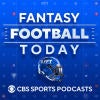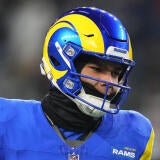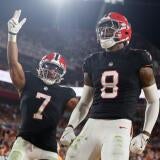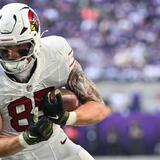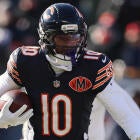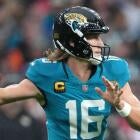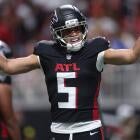Fantasy Football 2020: With no preseason and altered training camp, Covid-19 has altered projections again
The novel coronavirus will impact the 2020 NFL season, but projecting that impact is awfully difficult.
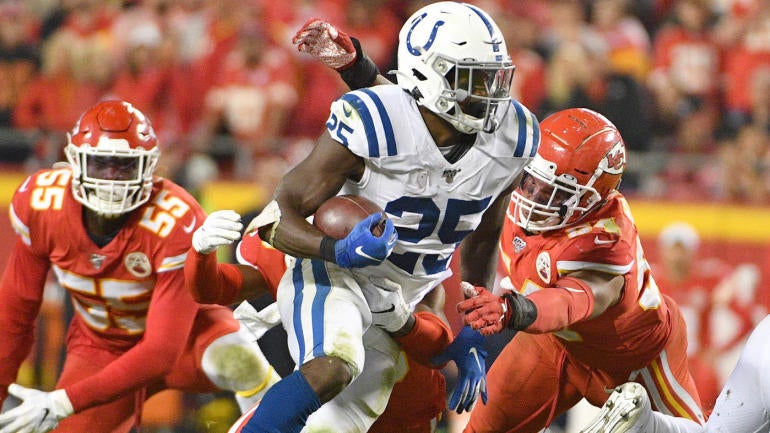
It's been clear for some time that Covid-19 would impact the 2020 NFL season. The 2020 NFL Draft was a virtual event, with teams getting less access to the players than they'd had in many years. OTAs and rookie camps were held virtually as well. Now the preseason has been cancelled entirely and NFL teams won't be practicing in full pads until August 17. This season is going to be different, but how?
My working assumptions since late March have been three-pronged:
- This could be really tough for rookies, especially early in the year.
- Quarterbacks and wide receivers changing teams could have a difficult time developing chemistry.
- Continuity will be an added bonus for NFL offenses.
Typically what I'd do is try to back test these theories, but in an unprecedented situation that is impossible. This is without precedent. The closest comp I could find to this offseason (and it's not that close) is the 2011 lockout. That season the players were locked out through the summer and didn't open training camp until August. Back in May I took a look at the 2011 season and it confirmed a lot of what I was concerned about.
The first thing you see when you look at the 2011 NFL Draft is a superstar: Cam Newton. Newton took the league by storm that season, throwing for more than 4,000 yards and running for 14 touchdowns. He threw for more than 400 yards in each of his first two games and finished as the No. 4 quarterback in Fantasy. And it doesn't stop there. A.J. Green was the No. 4 pick. He topped 1,000 yards as a rookie, including 10 catches for 124 yards and a score in Week 2. Julio Jones went over 900 yards in just 13 games, and had his first 100-yard game in Week 3. So much for slow starts, huh?
I was temped to give up right then. I'm glad I didn't because the most interesting thing I found was with the running backs. Now, this was a weird running back class. Mark Ingram was the only first-rounder. Ryan Williams was the next back taken (he was never able to stay healthy). Shane Vereen, Mikel Leshoure and Daniel Thomas rounded out the second round. Notably, DeMarco Murray, Stevan Ridley, Roy Helu, Bilal Powell, Jacquizz Rodgers and Dion Lewis were all taken after Round 2.
By my count that's nine running backs from the 2011 class who went on to have varying levels of Fantasy impact. Murray, Ingram and Ridley were the only must-start options, but Vereen, Rodgers, Powell and Lewis all went on to have at least one 50-catch season. Helu was the best of the group as a rookie and Leshoure scored nine touchdowns in his sophomore campaign.
So what did this these players look like as rookies?
Helu was the only back to score more than 150 PPR Fantasy points (Adrian Peterson scored 151 in 2019). Murray was the only other rookie back to top 100 PPR Fantasy points. Ingram would have got there if not for an injury, but his 9.1 PPR Fantasy points per game was nothing to write home about. At the end of the year there were no rookie running backs in the top 20 in PPR scoring. Two (Helu and Murray) did crack the top 30. Ingram and Kendall Hunter were the only other rookies in the top 50.
What went wrong? They were almost all in committees, got off to terrible starts and were almost universally ignored in the passing game. Helu caught 49 passes (14 in one game!), but no one else caught more than 26. That makes sense, considering how rookies can struggle with pass protection and an abbreviated offseason gives them less opportunities to prove themselves in that area.
How slow were those slow starts? Thomas was the only rookie in the top 40 in PPR scoring through four weeks. After Week 8, Ingram was the top rookie running back at RB34. Helu had one game with more than eight touches in the first half of the season. And it's not like these backs were stuck behind future Hall of Famers. Helu was sharing with Ryan Torain and Tim Hightower. Murray needed an injury to Felix Jones. Ingram shared early downs with Pierre Thomas. Vereen and Ridley were buried behind Danny Woodhead and BenJarvus Green-Ellis.
Now it's time to take a breath. Confirmation bias is very real. I told you at the start that my point was a shortened offseason could be bad for the rookies. What I've spent the past several paragraphs on is one season. That season was impacted by a lockout, not a pandemic. We have no idea how the careers of Clyde Edwards-Helaire, Jonathan Taylor, D'Andre Swift and JK Dobbins will compare to Mark Ingram, Demarco Murray, Roy Helu and Shane Vereen. I'm not telling you to avoid all rookie running backs because of what happened nine years ago.
At the same time, the 2011 class had a full preseason and a more normal training camp experience. This class won't even get that, and it doesn't seem to be scaring many away. There has been a small discount to the rookie running back ADP, but not enough if you were already concerned. From July 15-27, Edwards-Helaire (23.5) still has a second-round ADP and Jonathan Taylor (33.9) isn't that far behind. Cam Akers (52.7) and D'Andre Swift (53.8) are still being drafted in the fifth round. If they perform like the 2011 class, you won't regret fading them at that cost. And until Damien Williams opted out, I was fairly concerned this for this entire class.
Without Williams, Edwards-Helaire's primary competition for touches is DeAndre Washington, Darwin Thompson and Darrel Williams. No offense to those guys, but that shouldn't be much of a hurdle for a first-round pick, even if he doesn't get a full training camp. While I'm outright avoiding the other rookie backs being selected in the first five rounds, I'd be thrilled to land Edwards-Helaire in the early second round.
The rest of the positions from 2011 are harder to draw conclusions. Newton was incredible and Andy Dalton was fine. But Jake Locker, Blaine Gabbert and Christian Ponder were all top-15 picks and had dreadful rookie years (and careers for that matter). Jones and Green were both top-24 receivers, but does this class have a Julio Jones or an A.J. Green? Also, Torrey Smith was the only other rookie receiver in the top 40 at the end of the year. And you can see some of the same first half/second half splits at receiver.
Through the first eight weeks of 2011, Green was the only top-30 receiver in the class and only three rookies ranked in the top 50. From Weeks 9-17, Jones, Green and Smith were all top 30. Titus Young, Greg Little, Denarius Moore and Doug Baldwin joined them in the top 50.
If you thought the rookie section was discouraging, you aren't going to like the free agent and trade section much more. In fairness, there were a couple of running backs (Darren Sproles and Reggie Bush) who were fantastic with their new teams. Sproles had the best year of his career in 2011. But if you'll remember, I wasn't worried about free agent running backs. The pass catchers? Abysmal.
Chad Johnson, Braylon Edwards, Lee Evans and Sidney Rice all saw their careers fall apart in 2011 and never really bounced back. None of them had the sustained excellence of DeAndre Hopkins and most of them were older than Stefon Diggs, so I don't want to make a direct comparison there. But all of them were significantly worse and none of them ever had another Fantasy-relevant season again.
Johnson and Edwards were the only receivers in this group who could approach the talent of Hopkins and Diggs, but Johnson had started falling off the year before. I might just write all this off if the tight ends weren't equally terrible. Greg Olsen, Todd Heap, Zach Miller and Kevin Boss all changed teams in the same offseason. Only Olsen improved on his 2010, and that was a pretty minor improvement, going from TE23 to TE18.
You can roll your eyes and ignore all of the veteran pass catchers if you like. But if there's anything to take away, it's that nearly everyone but the running backs were worse, the quarterbacks included. But it's not like we have 2020 comps for an aging Donovan McNabb and Matt Hasselbeck changing teams at the end of their careers. Oh, wait.
McNabb flamed out in 2011 and never played again. Hasselbeck continued his mediocre play from the year before. They're closer to Philip Rivers than Tom Brady, and I would say it's a warning sign for expecting a change of scenery to help Rivers bounce back from what pretty clearly looked like a decline in 2019.
Finally, there's the continuity angle. While it would take a long time to do a complete study of the 2011 season from that angle, I can tell you that the Packers, Saints and Patriots were the only three teams to score 500 points in 2011. All three offenses returned their head coach, offensive coordinator, quarterback and top four receiving options from 2010.
Who can we say that about in 2020? Right now it looks like the Ravens, Seahawks, Lions, Bills, Titans and Raiders. Admittedly, that's a strange group of offenses and there's a different baseline for the Ravens than there is for the Raiders, but if continuity is an advantage in 2020, those teams stand to benefit.
Finally, this is one season we're talking about. We don't know how relevant it is to what is going to happen in 2020. A lot of weird things can happen in a given season. Remember Ryan Tannehill last year? But as we maneuver through an unprecedented preseason, I hope it helps to have a glance back at the last time we had an abbreviated offseason.
As for the projections themselves, I did make another round of changes in late July, once the NFL had agreed to no preseason and the limited contact. Every rookie (other than Edwards-Helaire) received a small downgrade to their touch and efficiency projection. I would definitely expect a couple of rookies to start fast and make that adjustment look foolish, but I can't imagine guessing which rookie will get fast-tracked when comparing similar prospects. I've also downgraded projections for Hopkins, Diggs, and the pass catchers changing teams, but not quite as much as I did the rookies. Finally, I downgraded the offenses with new head coaches. It's never easy to be a new head coach in the NFL, but this season makes it seem near impossible.
To finish on a positive note, there were a few players who saw upgrades to their projections. Marlon Mack and Kerryon Johnson find themselves in better position to open the season as the starting running back on their team. They're pretty good values on Draft Day as well. Courtland Sutton and Michael Gallup saw a small bump to their targets because I'm slightly less concerned about the rookies taking work away. Same for Darren Waller in Oakland.
While most of these adjustments were pretty small, a lot of small dings also meant that veterans on good teams with little turnover moved up in the rankings with these recent changes. If you want to be safe in the early rounds, selecting those players is the way to go. With how little we do know, it's comforting to be able to rely on those studs early.

